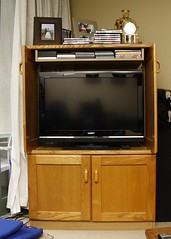I bought a new TV last week – a Sony KDL-32V5500. It’s a mid-range set, but is still fantastic compared to what you could get a year or two ago. Most 32 inch LCD panels seem to be only 720P (or 1366×768), and one thing that attracted me to the Bravia is that it’s 1080P (and the fact that the price was comparable to even generic panels).
One of the first things I noticed was that it has an ethernet port. It’s used for a feature called DLNA, which is a standard for streaming media between devices on a home network. This TV has two modes – a standard media player mode, or “renderer” mode. When acting as a media player, the TV reads files directly from a server device such as a NAS or computer with DLNA-compliant software running on it. When in renderer mode, the server transcodes the media into standard mpeg, before streaming it to the TV.
In terms of the end experience the two modes are similar, as you can pick and choose what to play via the TV’s interface in both modes. The difference is where the decoding is done (TV or Server). The advantage of renderer mode is that you can play any format which the server (generally a computer) can decode, which is far more than they could ever hope to build into a TV set. The disadvantages are that it requires a lot more bandwidth and resources on the server computer, and also much more capable software, as it has to be capable of transcoding the video stream. You also need a reasonably powerful CPU, and since the decoded stream has much less compression than the original, you need a gigabit network to stream even 720P losslessly without stuttering (forget about wifi).
DLNA seems to be a fairly new feature on TV sets, and the software base is not well developed. I tried a couple of basic (non-renderer mode) solutions such as ushare (included in the Ubuntu repositories), and minidlna, which is apparently developed by a Netgear employee for their NAS products. Minidlna seemed to work reliably, but I quickly found that the TV can not play most of my media collection, as few files showed up in the list (those that did show up worked reliably though). I recommend minidlna over ushare, as it’s more current, and ushare is apparently no longer updated.
I then stumbled across PS3MediaServer, which was designed to stream media to the Playstation 3. It’s an open source Java application, and does exactly what I want it to – transcode and stream media to a DLNA device. Unfortunately, the release version can only stream to the PS3 – the betas have support for some other devices but this a very new feature and it’s not without problems. But it’s good enough for now if you can put up with having to restart it now and again. As an added bonus it’s also cross platform, and can be run on Windows, Mac and Linux.
It did take a bit of tweaking to get right though. The most serious problem was that AVI files weren’t showing up, because the config file for the Sony Bravia 5000 series assumes that they can play all .avi files directly without transcoding, which mine certainly can’t. So you have to add .avi files to the “force transcode” list on the transcoding settings tab. I also found that bandwidth limiting seems to have no effect, and using anything other than the default Mpeg2 quality seems to stop media playback from working. It’s the best solution I can find for the moment though, so if you want to give it a try you can download the latest beta here.
For now this is no media PC replacement, but if you’ve already got TiVO/MySky or another set-top box and just want to play the occasional file from your computer it’s worth a look, and much less cumbersome than hooking up your laptop each time.
For anyone else researching DLNA stuff, here are some other useful links:




